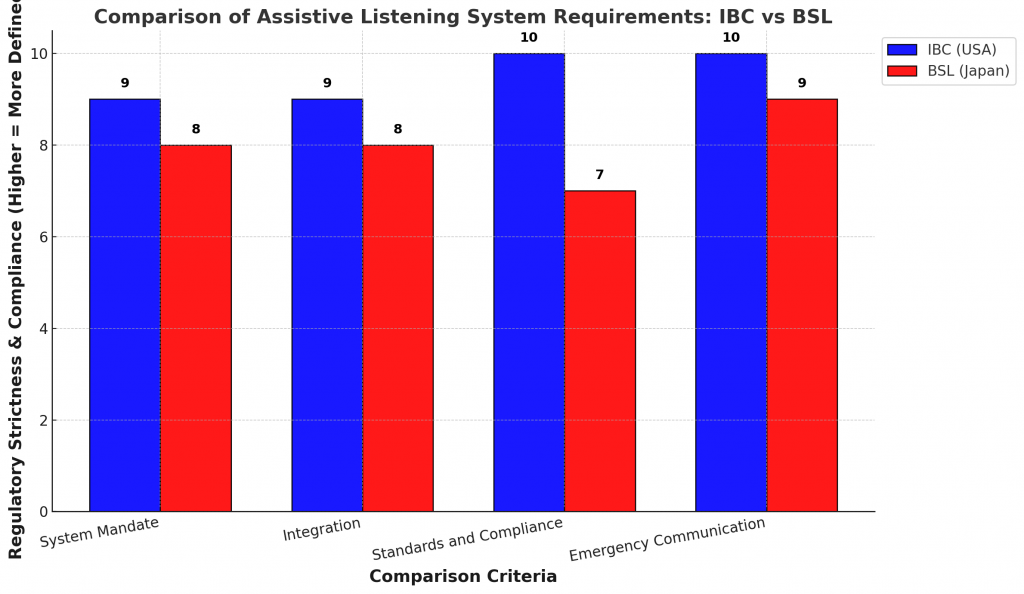General Definition
- Assistive Listening Devices (ALDs) are electronic systems designed to enhance sound clarity and improve auditory access for individuals who are deaf or hard of hearing in assembly areas, theaters, lecture halls, conference rooms, stadiums, and other public venues.
- These systems work by transmitting amplified sound directly to a listener’s hearing aid, cochlear implant, or dedicated receiver, reducing background noise and improving speech intelligibility.
- Building codes, including the Americans with Disabilities Act (ADA), International Building Code (IBC), and other accessibility regulations, mandate the installation of assistive listening systems in spaces where amplified sound is used to ensure equal access for individuals with hearing impairments.
- Assistive Listening Systems (ALS) are designed to enhance the auditory experience for individuals with hearing impairments in assembly spaces such as theaters, concert halls, and other Group A-1 occupancies. These systems ensure that essential audio information—including speeches, performances, and emergency announcements—is clearly delivered to all occupants.

IBC Approach to Assistive Listening Systems
- Mandatory Provision:
The IBC requires that large assembly spaces be equipped with assistive listening systems if they meet specific occupancy thresholds. These systems are often integrated with the building’s public address and sound reinforcement systems. - Detailed Integration:
The code outlines precise requirements regarding the placement and operation of ALS equipment. This includes ensuring that receivers (such as hearing aid-compatible devices) are readily available, and that the system is seamlessly integrated with emergency communication systems. - Standards and Compliance:
The IBC references related standards (including ADA and NFPA guidelines) to ensure that the system provides consistent performance, clear sound quality, and ease of use for individuals with hearing impairments.
BSL Approach to Assistive Listening Systems
- Flexible Implementation:
- Under the BSL, while the objective of providing effective auditory assistance is shared, the guidelines tend to be less prescriptive than the IBC. Local building practices and technological advancements often shape the specific requirements.
- Adaptable System Design:
- The BSL promotes integration of ALS within the overall design of the facility but allows for more variability in system type and installation methods. This flexibility enables designers to tailor solutions that best fit the local context while still ensuring accessibility.
- Emergency Communication:
Similar to the IBC, the BSL emphasizes the importance of maintaining reliable communication during emergencies. Systems must ensure that hearing-impaired individuals can receive clear and prompt emergency announcements.

| Comparative Table | ||
|---|---|---|
| Criteria | IBC | BSL |
| System Mandate | Required in assembly spaces meeting specific occupancy thresholds. | Required in large assembly spaces; guidelines are adaptable to local needs. |
| Integration | Detailed integration with public address, emergency, and sound reinforcement systems. | Integrated into overall design with flexible installation options. |
| Standards and Compliance | Aligns with ADA and NFPA standards for performance and reliability. | Emphasizes functionality with local adaptation; less prescriptive. |
| Emergency Communication | Ensures reliable emergency announcements via the ALS. | Designed to provide clear emergency communication as part of the facility. |
- Both the IBC and BSL recognize the importance of Assistive Listening Systems in ensuring equal access for individuals with hearing impairments.
- The IBC adopts a more prescriptive approach with detailed requirements for system integration and compliance with national standards, while the BSL allows for a more flexible implementation tailored to local design practices.
- Ultimately, both codes aim to guarantee that occupants receive clear and reliable auditory information during regular operations and emergencies.
Recommendations for Improvements
- Assess Local Regulatory Requirements:
- If your facility is in the United States, aligning with IBC standards—which include detailed integration with ADA and NFPA guidelines—will likely simplify permitting and compliance.
- For projects in Japan or regions following BSL, adapt the design to the more flexible, locally informed guidelines.
- Adopt a Hybrid Approach When Feasible:
- For international projects or when seeking global best practices, consider a hybrid strategy.
- Use the IBC’s prescriptive details as a foundation to ensure robust system performance, while incorporating the BSL’s flexibility to accommodate local design nuances.
- Engage Multidisciplinary Expertise:
- Involve acoustical engineers, accessibility consultants, and emergency systems experts early in the design phase. Their combined insights can help optimize the system’s integration with public address and emergency communication systems, ensuring that all stakeholders—especially individuals with hearing impairments—are effectively served.
- Plan for Future Scalability and Upgrades:
- Given the rapid evolution of technology, select equipment and system configurations that allow for future upgrades. This ensures that the system remains current with emerging standards and technological improvements, whether mandated by IBC or evolving BSL practices.
- Conduct Rigorous Testing and Validation:
- Implement thorough performance testing—including real-world simulations of emergency scenarios—to confirm that the assistive listening system meets both regular operational and emergency communication requirements.
- Regular testing helps maintain system reliability and user confidence over time.
- Document Integration and Compliance Measures:
- Maintain detailed records of system design, installation, and testing procedures. Documentation will be invaluable for future audits, maintenance, and when seeking certification or compliance verification with either IBC or BSL standards.
Summary
- IBC (USA):
- Requires assistive listening systems (ALS) in large assembly spaces that meet occupancy thresholds. Systems must be integrated with public address and emergency communication and follow ADA and NFPA standards for clear sound quality and accessibility.
- BSL (Japan):
- Takes a flexible approach, allowing local building practices and technology advancements to shape requirements.
- ALS must be integrated into facility design with adaptable installation methods. Like IBC, BSL ensures emergency communication accessibility for the hearing-impaired.
- Best Practice: Combine IBC’s prescriptive standards with BSL’s flexibility to allow for effective and context-specific ALS implementation.
